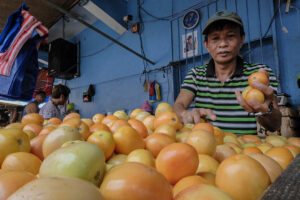By Gonzalo J. Varela
THIRTY-SEVEN years ago, when this newspaper was reformed under this new name, the average Filipino earned less than one tenth of the income of the average high-income person. Since then, the Philippine economy has experienced significant growth. Today, that same average Filipino earns almost one-third of the income of his peers in high-income countries — still a large gap, but a narrowing one. The value Filipinos add at work has doubled in real terms since the late 1980s. But that growth was not uniform over the 37 years. The past decade, even with the COVID-19 shock that wiped out 10% of the Philippines’ income in one year alone, showed as much growth as the other 27 years combined.
This recent growth has three distinct features: it’s about catching up, a better use of resources, and an inward shift.
The first distinct feature is catching up. At the household level, incomes of the poorest families have grown faster than those of the better-off families, reducing income disparities. To be sure, income disparities in the Philippines are still among the highest seen in East Asia, but they narrowed during the past decade. At the firm level, productivity improvements were most pronounced among mid-level firms, which grew about 30% faster than leading firms. The catch-up is positive, and even natural. Yet, sustained growth requires innovative leading firms that keep pushing the boundaries of productivity. Regionally, labor productivity gains were stronger in less developed areas — take region XII in Mindanao, or Eastern Visayas — than in the National Capital Region, thus helping reduce the long-standing income gaps between different parts of the country.
The second distinct feature of growth is a better use of resources. If Carlos Yulo had been forced to box, and Nesthy Petecio and Aira Villegas to be gymnasts, the Philippines would have not secured the three medals it did in Paris. They excelled by focusing on their strongest fields. Similarly, over the past decade, the Philippines benefited from aligning resources with their most productive uses. Many workers moved from informal, self-employment activities, often in agriculture, to higher-productivity, formal, wage employment that increased by nearly ten percentage points over the past decade. While these job changes have boosted overall productivity, many of the new jobs still offer unstable work conditions and few benefits. When focusing on firms, the most productive ones are the ones that employ the most workers. In manufacturing, the most productive 20% of firms employ 46% of workers, while the least productive 20% employ only 6%. In services, the shares are 31% versus 10%. This part is good news. However, because the leading firms have not been all that dynamic, the new jobs are not being created by the most productive, but rather those in the middle of the distribution. Ensuring the most productive recover dynamism will be crucial to sustain allocative efficiency.
The third distinctive feature of the past decade’s growth was its inward focus. As the economy grew, sectors not exposed to international competition, known as non-tradable sectors, such as construction, for example, saw faster asset growth than those engaged in international trade, such as food production or business process outsourcing. While this is a common trend for growing economies, it also presents risks. Vietnam, for example, which during the period grew on par with the Philippines (even slightly faster), it did so while becoming more outward-looking, promoting foreign direct investments and deepening its integration with the global economy.
The Philippines saw its export-to-gross domestic product ratio decline from 34.7% in 2010 to 26.7% in 2023. Over that period, the number of exporting firms also fell to 2,750 from about 3,500. This inward shift could limit future growth. In the Philippines, firms that engage in international trade are typically about 2.5 times more productive than those focused solely on the domestic market, and they get more productive as they export more systematically. Exposure to global competition drives innovation and efficiency, as firms learn and adapt — a concept known as “infusion.”
Our Olympians can help illustrate. Yulo, Petecio, and Villegas didn’t win their medals by competing only at home or erecting artificial barriers so that others could not beat them. They trained hard, exposed themselves to tough international competition, and incorporated global best practices into their routines. In a similar way, firms need to look outward, adopt technologies, modern management practices, and continuously innovate to stay ahead.
Looking ahead, the global economic environment presents new challenges that the Philippines must navigate carefully. Global growth potential, the rate at which the world economy can expand without causing inflation, is expected to drop to a three-decade low by 2030. This decline is driven by falling productivity growth, weaker international trade, and geopolitical tensions that have led to more protectionist industrial policies.
Climate change has moved from a future threat to a present reality. Adapting to it increasingly demands more of the limited fiscal space and requires modifying business strategies. Decisions on infrastructure investment, business locations, and production methods are increasingly shaped by the need to build resilience against climate impacts, or to produce in a way that helps mitigate it. The rapid advancement of technologies, particularly artificial intelligence (AI), also presents both opportunities and risks. In sectors like BPO, which has been key to the Philippines’ growth, AI could either enhance the country’s competitive edge by complementing workers’ skills, or undermine it by substituting labor, depending on how both policy makers and businesses respond.
To sustain growth in this changing environment, the Philippines needs to focus on three critical areas: enhancing competition and global integration, investing in skills, and strengthening institutions.
Competition and integration are essential. Recent reforms in sectors like logistics, telecommunications, and renewable energy are positive steps. These reforms, when fully implemented, will attract investment, boost competition, and improve the efficiency of these key sectors, leading to broader economic benefits. Additionally, reducing cross-border trade and investment costs will help facilitate knowledge transfer and productivity growth. Deep trade agreements are effective instruments to decrease these costs and can also help counter the negative effects of protectionist policies.
Investing in skills is just as important. The Philippines faces high levels of learning poverty and stunting problems that directly impact long-term growth. Investing in health and education from an early age is critical, but it’s also important to provide continuous training opportunities that allow workers to adapt to and use new technologies like AI, rather than be replaced by them.
Finally, institutional development is necessary for sustained growth. Efficient and accountable public administration is key to the effective design and implementation of policies. Good data and continuous monitoring and evaluation are important to assess outcomes and adjust as necessary. For the Philippines, strengthening the capacity of local governments is particularly important to support the spatial economic convergence that has contributed to so much growth over the past decade.
The challenges ahead are real, but so are the opportunities. By focusing on competition, embracing integration into the global marketplace, skills upgrading, and institutional development, the Philippines can continue its upward trajectory, and even accelerate its growth potential, moving closer to its goal of becoming a prosperous middle-class society by 2040. The future holds great promise if the reform momentum is maintained.
Gonzalo J. Varela is World Bank lead economist and program leader of the Equitable Growth, Finance and Institutions Practice Group for Brunei, Malaysia, the Philippines, and Thailand, based in Manila















